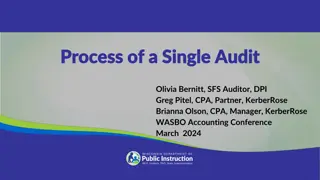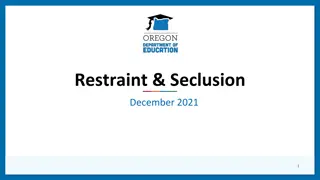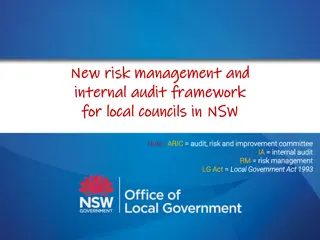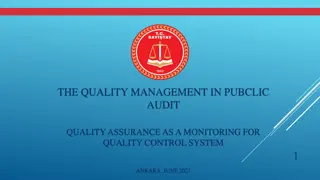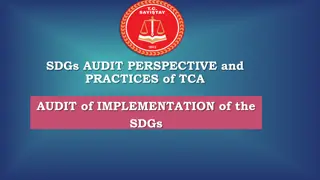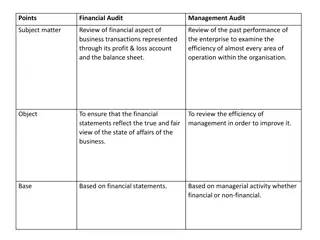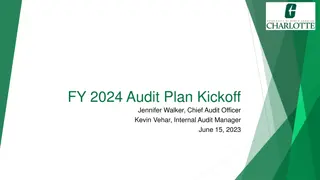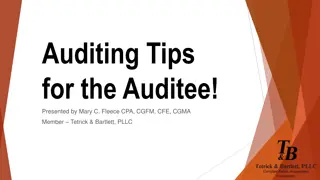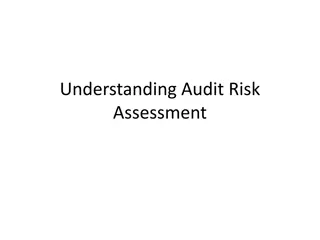Education Equity Implementation and Audit Reminders
Education equity requires the fair allocation of resources and opportunities for marginalized individuals. This includes dismantling oppressive systems. The document also emphasizes important audit reminders for correcting data inaccuracies in the reporting period.
Download Presentation

Please find below an Image/Link to download the presentation.
The content on the website is provided AS IS for your information and personal use only. It may not be sold, licensed, or shared on other websites without obtaining consent from the author.If you encounter any issues during the download, it is possible that the publisher has removed the file from their server.
You are allowed to download the files provided on this website for personal or commercial use, subject to the condition that they are used lawfully. All files are the property of their respective owners.
The content on the website is provided AS IS for your information and personal use only. It may not be sold, licensed, or shared on other websites without obtaining consent from the author.
E N D
Presentation Transcript
Second Period Cumulative ADM 2023-24 Training Data Owner: Amanda Leopard November 30, 2023 Education equity is the equitable implementation of policy, practices, procedures, and legislation that translates into resource allocation, education rigor, and opportunities for historically and currently marginalized youth, students, and families including civil rights protected classes. This means the restructuring and dismantling of systems and institutions that create the dichotomy of beneficiaries and the oppressed and marginalized.
Agenda General Reminders Collection Dates Collection Purpose Important to Second Period Tuition Type Codes FTE Session Days Days Present Days Absent Enrollment and End Dates Calculated ADM Amount Additional Help & Contacts Online Resources ODE Data Collection Team Regional ESD Partners & ODE Helpdesk
Collection Dates Reporting Period: July 1, 2023 December 29, 2023 Collection Window Open December 7, 2023 January 8, 2024 Collection Closed To All January 9, 2024 January 10, 2024 Audit Review Window (Open to All) January 11, 2024 January 19, 2024 Collection Closed (Opened by request) January 20, 2024 June 28, 2024 Fall Membership Validation Window is November 2, 2023 January 19, 2024 Public release of the 23-24 Student Enrollment Report is in February 2024
Important Audit Reminder First Round Audits January 11, 2024 January 19, 2024 The last day to make changes to First Period Cumulative ADM is January 19, 2024. Ensure that someone is available between January 11 at 1PM and January 19 to research audits that pertain to changing data in First Period Cumulative ADM. Failure to correct First Period Cumulative ADM data inaccuracies found in Second Period Cumulative ADM audits could affect Fall Membership reporting. Contact your Regional ESD Partner or the Data Owner to get your First Period Cumulative ADM collection reopened for correction.
Important Audit Reminder Possible Audits to Review First Audits that Compare Second Period to First Period Audit Type 15 Student Identifying Issues (requires a change in First or Second Period) This record indicates that the student was enrolled on the fall/spring membership snapshot date, but the student was not reported as enrolled in this school on the snapshot date in first period. This record indicates that the student was NOT enrolled on the fall/spring membership snapshot dates, but the student was reported as enrolled in this school on the snapshot date in first period. Audit Type 14 Inconsistently Reported Flags (requires a change in First or Second Period) [Flag] marked Y in this attending district last period, but N in this period. Please verify that N is correct, or change it to Y. Audit Types 11 or 12 Daily or Hourly Enrollment Issues (requires a change in First or Second Period) 11: Inconsistently Reported Instructional Hours between Reporting Periods. 12: Inconsistently Reported Membership Days. & Student was reported with daily enrollment last period, but not this period, within this attending school. All changes to First Period Cumulative ADM records must be made no later than the end of the day on Friday, January 19.
Data Submission Audits Second Round Audits After First Round Audits close on January 19, 2024, ODE produces Second Round Audits which are sent out via the ESD Partners in a spreadsheet via Secure File Transfer. If you receive Second Round Audits, your collection will be reopened for an extended period of time. Use this spreadsheet to find new audits that were not part of your First Round Audits, or to find audits that were confirmed as fixed or approved in the First Round Audits but are still believed to have possible reporting problems. Do not clear an audit if you are unsure what it is asking for. Contact the ESD Partners or myself to get clarity. Review the Comment field on the spreadsheet to find what is being audited and additional information to help correct or confirm the audit. The Cumulative ADM Audits and Review Manual provides additional information for what an audit is reviewing and how to correct it. Corrections are made in Second Period CumADM. Locate the records by navigate to Record Management and Record Maintenance in the collection and search by the student s SSID. Audits that would require a change to First Period CumADM will not be correctable.
General Reminders Important General Reminders If a student is enrolled on December 29, the last weekday of the Second Period Cumulative ADM Reporting Period, the end date reported in the collection should be the first weekday after that. In 2023-24, the end date will be January 1, 2024. Program Type 13 may only be used as a temporary placeholder and must be replaced with membership information once it is known. Resident County refers to the county where the student's parents or guardians live, or where the student lives in the case of legally emancipated minors or students over 18. It is nota reflection of the district s county. If you have a request for First Period Cumulative ADM to be re-opened for correction while Second Period Cumulative ADM is open, you will see both collections available. The resident district and resident school fields are important because the funding flows to the resident school district when the tuition type code is reported as State funded.
Collection Purpose State School Fund Estimates Fall Membership Report Validation Compared against First Period Cumulative ADM for Audits
Important to Second Period Important Data Elements Tuition Type Code Enrolled Date End Date Session Days Days Present Days Absent Instructional Hours Full Time Equivalency Calculated ADM Amount
Important to Second Period Tuition Type Codes Tuition Type Codes The Tuition Type Code indicates the tuition type the student is enrolled under during the reporting period. Tuition Type Code S (State Funded) ADM goes to the resident district. Tuition Type Code F (Fully State funded) Funds for the student placement in the program are provided directly to the contractor operating the program by ODE. Fully state funded programs are Oregon Department of Education Long Term Care and Treatment Facilities, Hospital Programs, and the Oregon School for the Deaf. The resident district does not receive state school funds. Tuition Type Code P (Paid Tuition) Tuition for the student is paid from a source other than the state school fund. The resident district does not receive state school funds. Students who are paid tuition are required to be reported in the Cumulative ADM collection.
Important to Second Period Enrolled Date Enrolled Date The Enrolled Date should reflect the first day of the student s actual attendance in an institution or program type. Enrollment does not begin when the students complete their enrollment forms, but when the student actually begins attending. Full Time Programs (typically Program Type 1) require at least half of a day of attendance for enrollment to begin. Exception: A student with an excused absence of less than ten school days at the beginning of the school year may be counted in membership prior to the first day of attendance, but not prior to the first calendar day of the school year, if the status has been verified by contact with the parent or guardian. If the student does not actually attend during the first ten session days of school, the student s ADM Enrollment date must reflect the student s actual first day of attendance. A student may not be reported with only days absent. The Enrolled Date for a Program Type 14 record should be the date of that outcome that is being reported. Reminder: Program Type 14 records reported in First Period need to be reported in Second, Third and Annual collections.
Important to Second Period End Date End Date The End Date is the weekday after the student withdrew from the institution or the program type either through early withdrawal, a change of circumstances, or at the end of the reporting period or school year. If the student is still enrolled at the end of the period, the ADM End Date should reflect the first weekday after the end of the period. The date on which the ADM End Date occurs may not be counted as a day present or a day absent. Example: If the student is still present at the end of the Second Period Cumulative ADM reporting period (December 29), the student s record should have an End Date of January 1. If the student withdraws prior to the end of the period or prior to the end of the school year, the ADM End Date should reflect the first weekday following their withdrawal. The date on which the ADM End Date occurs may not be counted as a day present or a day absent. Example: The student s last day of enrollment was November 16, 2023. Their End Date would be reported as November 17, 2023.
Important to Second Period Session Days Session Days Session Days signify prescheduled weekdays during which the majority of students within the same school/grade level are scheduled to be present under the guidance and direction of appropriately licensed instructional staff, and there is an expectation that the majority of students within the school/grade level would be in attendance. Session Days should increase for all students, regardless of their enrollment dates, for each Cumulative ADM period that the school and grade has classes. The number of session days should be the same for all students in the same school and grade. Some grades have more or fewer session days than other grades in the same institution, such as grade 12 students who may end earlier than the rest of a school, or kindergarten students who may start late. The session days should accurately reflect situations like these. Days in which attendance is optional and additional days provided that are outside the bounds of the time scheduled for the majority of students in the school/grade level may not be counted as a day in session. This includes emergency closures (e.g. snow days). Summer school may not be counted as session days. Find additional information about Session Days, Days Present, and Days Absent in the First Period Cumulative ADM web training from September 14.
Important to Second Period Attendance Information Days Present Online Instruction For remote instructional models, schools and districts must take daily attendance. Attendance should be demonstrated in a set 24-hour window that the school establishes and communicates to families prior to the school year. The 24-hour window is not required to be from 12:00 a.m. to 11:59 p.m. Attendance for remote instruction models will be defined to include both participation in class activities and substantive interaction with a licensed or registered teacher during a school day or substantive interactions with educational assistants, paraprofessionals, and TAPP family advocates that support meaningful learning and/or attend to student mental health and well- being. Substantive interactions can be evidenced by any of the following or reasonable equivalents: Active participation in a video class; A meaningful series of two-way communications between student and teacher via chat, text message, communication app or email; A sustained phone call between the teacher or educational assistants/paraprofessionals and the student, or, for younger students, with the parent or guardian of the student.
Important to Second Period Attendance Information Days Absent Days Absent is the number of days the student was recorded as absent from school during the reporting period whether excused or unexcused. Beginning in 2019-20, all time spent engaging in school-sponsored extracurricular activities during the official school day (including travel) will be counted as time present in the Cumulative ADM data collection. Executive Numbered Memo 003-2018-19 Absent and Present Reporting in Cumulative ADM
Important to Second Period Attendance Information Instructional Hours Instructional Hours is the number of hours of instruction received by a student during the reporting period. Only hours the student actually attended may be counted, not those that they were scheduled to receive but did not attend for. Additional Guidance: Hours of Instruction Reporting Cumulative ADM Calculations by Program Type
Important to Second Period Full Time Equivalency (FTE) Full Time Equivalency (FTE) Students participating in more than one-half of the full-day program shall be given a Full Time Equivalency (FTE) of 1.0. Students participating in one-half or less of the full-day program shall be given an FTE of 0.5. FTE for students on block schedules is determined by looking at the student s entire schedule. Program Types 1, 2, and 3 are reported with FTE as either 1.0 or 0.5. Report all kindergarten students in Program Type 15 as 1.0 FTE. ODE will adjust the ADM for these students. Students who are not in a program that offers full-time instruction should be reported with hours of instruction (previous slide). Hours of Instruction Reporting Guidance
Important to Second Period Calculated ADM Calculated ADM Amount (CalcADMAmt) The Calculated ADM Amount is a field in Cumulative ADM Collections that is calculated by ODE after records have been submitted. For Program Type 1, the Calculated ADM Amount is based on specific formulae that is dependent on the ADM Program Type Code used in the record. Program Type 1 uses the formula: (Present Days + Absent Days) / Session Days * FTE) Additional calculation methods can be found on the Cumulative ADM Calculations by Program Type guidance document. Second Period Cumulative ADM is used for State School Fund Estimates. Review the Calculated ADM Amount field for accuracy to ensure estimations are accurate. Note: CalcADMAmt does not account for ADM that is adjusted by School Finance, such as weighting.
Additional Help & Contacts Online Resources Online Resources Cumulative ADM Resources Webpage Cumulative ADM Manual Cumulative ADM Audits & Review Manual Cumulative ADM Additional Guidance Documents Cumulative ADM Contacts Additional Resources Data Collection Committee (DCC) Meetings Assessment and Accountability Update (Subscribe)
Additional Help & Contacts Regional ESD Partners & ODE Helpdesk Regional ESD Partners Karen Brown Smith (800) 706-4447 x 3124 karen.brown@imesd.k12.or.us Peter Campbell (800) 706-4447 x 3203 peter.campbell@imesd.k12.or.us ODE Helpdesk For Technical Help (File Upload Issues, SSID Merges, Application Issues) (503) 947-5715 ODE.Helpdesk@state.or.us
Additional Help & Contacts ODE Data Collection Team ODE Data Collection Team Robin Stalcup Paul Skomsvold Eric Gillis (503) 947-0849 | robin.stalcup@ode.oregon.gov (971) 208-0296 | Paul.Skomsvold@ode.oregon.gov (503) 508-5132 | eric.gillis@ode.oregon.gov Data Collections/Validations: Fall Membership/Student Enrollment Class Size Data Collections/Validations: Graduation/Dropout Reporting Regular Attenders 9th Grade on Track Data Collections/Validations: Staff Assignment IUID Teacher Qualification Validation Ryan Clark Amanda Leopard (503) 947-5632 ryan.clark@ode.oregon.gov (503) 508-6472 amanda.leopard@ode.oregon.gov Data Collections/Validations: Class Roster Staff Position Staff FTE/Ethnicity/Retention 9th Grade on Track Data Collections/Validations: Cumulative ADM Institutions



